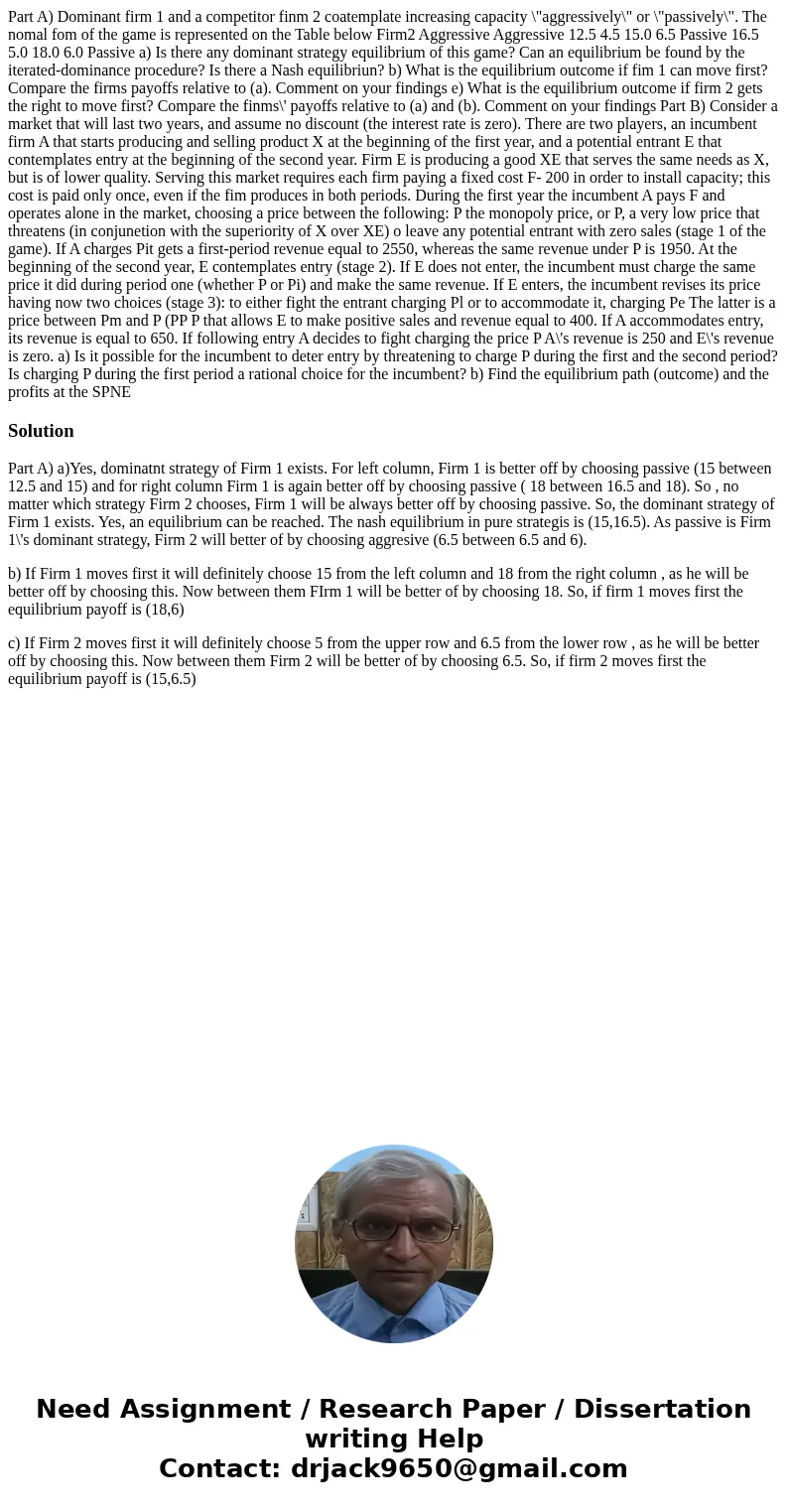Part A) Dominant firm 1 and a competitor finm 2 coatemplate increasing capacity \"aggressively\" or \"passively\". The nomal fom of the game is represented on the Table below Firm2 Aggressive Aggressive 12.5 4.5 15.0 6.5 Passive 16.5 5.0 18.0 6.0 Passive a) Is there any dominant strategy equilibrium of this game? Can an equilibrium be found by the iterated-dominance procedure? Is there a Nash equilibriun? b) What is the equilibrium outcome if fim 1 can move first? Compare the firms payoffs relative to (a). Comment on your findings e) What is the equilibrium outcome if firm 2 gets the right to move first? Compare the finms\' payoffs relative to (a) and (b). Comment on your findings Part B) Consider a market that will last two years, and assume no discount (the interest rate is zero). There are two players, an incumbent firm A that starts producing and selling product X at the beginning of the first year, and a potential entrant E that contemplates entry at the beginning of the second year. Firm E is producing a good XE that serves the same needs as X, but is of lower quality. Serving this market requires each firm paying a fixed cost F- 200 in order to install capacity; this cost is paid only once, even if the fim produces in both periods. During the first year the incumbent A pays F and operates alone in the market, choosing a price between the following: P the monopoly price, or P, a very low price that threatens (in conjunetion with the superiority of X over XE) o leave any potential entrant with zero sales (stage 1 of the game). If A charges Pit gets a first-period revenue equal to 2550, whereas the same revenue under P is 1950. At the beginning of the second year, E contemplates entry (stage 2). If E does not enter, the incumbent must charge the same price it did during period one (whether P or Pi) and make the same revenue. If E enters, the incumbent revises its price having now two choices (stage 3): to either fight the entrant charging Pl or to accommodate it, charging Pe The latter is a price between Pm and P (PP P that allows E to make positive sales and revenue equal to 400. If A accommodates entry, its revenue is equal to 650. If following entry A decides to fight charging the price P A\'s revenue is 250 and E\'s revenue is zero. a) Is it possible for the incumbent to deter entry by threatening to charge P during the first and the second period? Is charging P during the first period a rational choice for the incumbent? b) Find the equilibrium path (outcome) and the profits at the SPNE
Part A) a)Yes, dominatnt strategy of Firm 1 exists. For left column, Firm 1 is better off by choosing passive (15 between 12.5 and 15) and for right column Firm 1 is again better off by choosing passive ( 18 between 16.5 and 18). So , no matter which strategy Firm 2 chooses, Firm 1 will be always better off by choosing passive. So, the dominant strategy of Firm 1 exists. Yes, an equilibrium can be reached. The nash equilibrium in pure strategis is (15,16.5). As passive is Firm 1\'s dominant strategy, Firm 2 will better of by choosing aggresive (6.5 between 6.5 and 6).
b) If Firm 1 moves first it will definitely choose 15 from the left column and 18 from the right column , as he will be better off by choosing this. Now between them FIrm 1 will be better of by choosing 18. So, if firm 1 moves first the equilibrium payoff is (18,6)
c) If Firm 2 moves first it will definitely choose 5 from the upper row and 6.5 from the lower row , as he will be better off by choosing this. Now between them Firm 2 will be better of by choosing 6.5. So, if firm 2 moves first the equilibrium payoff is (15,6.5)

 Homework Sourse
Homework Sourse